British driver Lewis Hamilton, by that point already a five-time Formula One world champion, steers his Mercedes into the pit lane. One of his team of mechanics sprints to the garage, clumsily bumping into a colleague running out with a new set of tyres.
Hamilton’s race has already been interrupted for 17 crucial seconds.
The technician sprints to the left side of his car. The rules require all drivers to make at least one pit stop, and to change their cars’ tyres at least once in a race. To the right side of Hamilton, a second mechanic, burning cigarette still clasped between his lips, tears the wrapping from another tyre.
The clock is ticking: 25 seconds.
The broken front wing finally comes loose from the silver racing car. Mechanics trade places like unwieldy figure skaters, one with the old part in his arms and the other clutching the new part. A third stands motionless, in a dentist-green uniform, watching the spectacle with disillusion.
40 seconds.
A seemingly important figure from the Mercedes garage – white T-shirt, headset – steps into the chaos. A mechanic passes, then stops in his tracks at the car’s front wheel. How long is this misery going to last?
55 seconds.
The camera zooms in on Hamilton. In the lower right corner of the television screen, countless coloured dots – the cars of Hamilton’s competitors – pass the stationary Mercedes.
A full minute has passed before Hamilton is finally back on the track. The visor on his helmet conceals Hamilton’s eyes, but I imagine them burning with anger and indignation. He’ll have to make up a full lap on his opponents.
About an hour later, the British driver crosses the finishing line. The German Grand Prix on 28 July 2019, went down in history as a major disappointment for Hamilton. But even after the pit stop fiasco, he finished in ninth place, notching up two points towards his eventual championship win.
Scraping a place near the bottom of the Top 10 may not sound impressive. But keep in mind that to complete a single lap in the German Grand Prix takes just over one minute. Even after that wasted time in the pit lane, Hamilton kept five other drivers behind him. How on earth is that possible? Is it the man or his Mercedes?
The road to success is never straight
Success rarely comes about due to one factor. It’s almost always down to a mixture of knowledge, experience and luck, good and bad. The trick is knowing how important each of these factors is, and when: that’s the difference between winning and losing.
Mike Shinoda, vocalist in the US rap group Fort Minor, once described the ingredients for success in his industry as “10 percent luck, 20 percent skill, 15 percent concentrated power of will, 5 percent pleasure, 50 percent pain”. That’s a rhyming lyric, not data science. But it may just convey a kernel of truth when it comes to Formula One.
Nico Rosberg, a German driver who won the Formula One World Championship in 2016, has spoken in similar terms about the “80/20 rule”. Following this theory, driving skills account for 20% of a winner’s success, while his team is responsible for no less than 80%. That’s quite a statement. A world champion who downplays his own contribution to that success to just one-fifth of the whole achievement?
So, does the 80/20 rule really apply in the world’s 10th-biggest sporting competition? And if it is true, what do these proportions actually describe? In 70 years of Formula One, more than 800 drivers have taken part – most of them long since forgotten. This is unsurprising: the average driver competes in only 30 races and never wins one. How do you measure the talents of a Formula One driver?
Winners capture the imagination of millions of fans worldwide. The same names invariably top any list of the best drivers of all time: Ayrton Senna, Michael Schumacher, Lewis Hamilton. Often, these claims are based on the number of world championship titles or driving style. But what are the criteria to define greatness?
A Swiss study in 2009 concluded that the best driver of all time is actually Juan Manuel Fangio of Argentina. Why? Statistically, he won 47% of all his races (90% of drivers never win a race) and made it to the podium in 68%. He scored points in 84% of his races (about two-thirds of drivers never score a single point in their entire careers). That’s one definition of a Formula One driver’s achievements.
On the other side of the world, Andrew Phillips, an Australian whose day job was as a sleep researcher at Harvard, came up with another model to determine the best Formula One driver in history. World titles and lap times are impressive, he thought, but not the best objective measures of a driver’s quality. Often, he writes, “a driver’s true skill has been masked by their driving an unreliable or slow car”. It follows that even a driver who scores no points and never becomes a champion could still be better than the competition winner on the podium.
Winning isn’t everything
Instead of focusing only on winners, or those drivers who win consistently, Phillips argues that a more accurate ranking could be achieved by asking a better and sequenced question. First: what result can reasonably be expected from a driver, taking into account his car and the team behind it? Next: by how wide a margin does he exceed this benchmark of reasonable expectations?
In the course of the 64 racing seasons which he examined, Phillips identified 38 times when another driver outperformed the trophy winner, according to his criteria. Phillips didn’t just look at "one-hit wonders" (drivers who performed incredibly well in one season) like the German-Austrian Jochen Rindt until his untimely mid-season death in 1970. He studied the course of drivers’ careers over three- and five-year spans, as well.
Applying Phillips’s methodology, the upper echelons of Formula One look entirely different. By his calculations, the best Formula One driver of all time is Jim Clark, whose stellar career was cut short when he crashed fatally into trees next to a circuit in Germany in 1968.
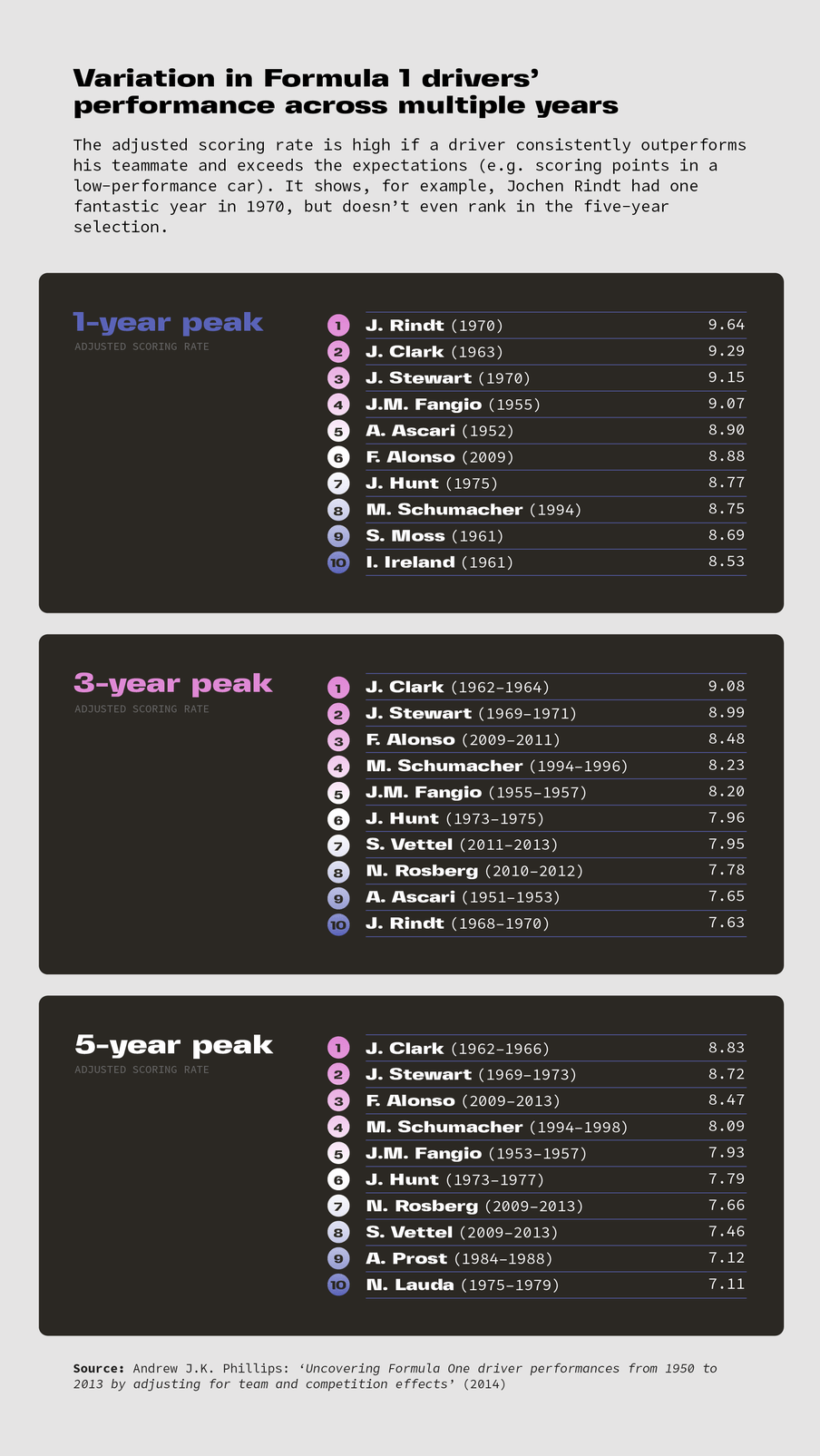
Drivers’ performance varies widely when the relative strengths of their teams are considered. An important factor here is that drivers often change teams and hence cars. On average, a driver will compete in seven different cars in a Formula One career. “Differences in performance between teams are typically larger than differences in performance between drivers in Formula One,” concludes Phillips.
For as long as a driver stays with the same team, it’s pretty easy to predict how he will perform. Research from the universities of Sheffield, Bristol and Aarhus shows that, year-on-year, the performance of about two-thirds of all Formula One teams remains constant. Researchers have attributed 86% of the relative differences in drivers’ performance to the effectiveness of their teams.
That leaves 14% of their performance attributable to drivers, a proportion which “might sound small, but it isn’t negligible”, according to Andrew Bell, researcher and first author of a large-scale study by the University of Sheffield. “If it was only the car, and [had] nothing to do with skill, the cars in the same team would cross the line at the same time,” he adds.
Fully relying on one variable is not an option, the Dutch former Formula One driver Jan Lammers told me. “Both material and personnel have to function 100%. It’s the sum total that determines the result. If your car and driver are both at 90%, you’ll get done more than if that ratio is 100%-75%.”
Bell’s analysis is also endorsed by Phillips. “We routinely see very large performance differences between teammates, in some cases approaching ~1 sec per lap,” Phillips writes from his current workplace at Monash University, located in a Melbourne suburb, a 20-minute drive from Australia’s grand prix circuit. Differences in performance, Phillips says, are “at least this large between the best and worst F1 drivers on the grid”.
Bell and his colleagues have demonstrated convincingly that data can predict performance. From behind their screens of tables and graphs, their blended criteria for teams’ performances enabled them accurately to calculate the top three drivers over multiple seasons with an accuracy of 94%. The data forecasts failed only twice: one high-performing driver was killed, and another broke his leg.
The cold light of data
Viewed in this light, seemingly spectacular outcomes start to look more predictable. Remember when Lewis Hamilton, despite a full minute of bad luck, still caught up with Polish driver Robert Kubica? Well, it turns out that driving skills are less decisive than spectators might have assumed: a bigger difference was that Kubica’s car had to race against Hamilton’s lightning-fast Mercedes. In fact, his skills as a driver are impressive: several studies rank Kubica among the 30 best Formula One drivers of all time.
Formula One, in fact, consists of two races within one competition: there are drivers, and then there are their cars. Giedo van der Garde, a Dutch former Formula One driver, confirms this: “I’ve also experienced it,” he tells me when we speak on the phone. In 2013, van der Garde’s only season in the world’s biggest motor sport, he consistently drove laps that were about two and a half to three seconds slower than [Sebastian] Vettel, who became that year’s champion. “A few years earlier, I was still driving with [Vettel] in Formula Three – he was my teammate – and then we were about as fast: one or two tenths [of a second, apart] at most,” he recalls. In Formula One, “yeah, it does come down to the car you’re in”.
These are among the unusual features of competitive motor sport. When you look for differences between drivers, you find an uncommon equality: a level playing field where individual performance is much closer, much less unequal, than in – say – major American ball sports or European football leagues. But if you only look at the performance of Formula One teams, you find the opposite: the distribution of trophies in Formula One is more unequal than – say – income disparities in Angola or Colombia.
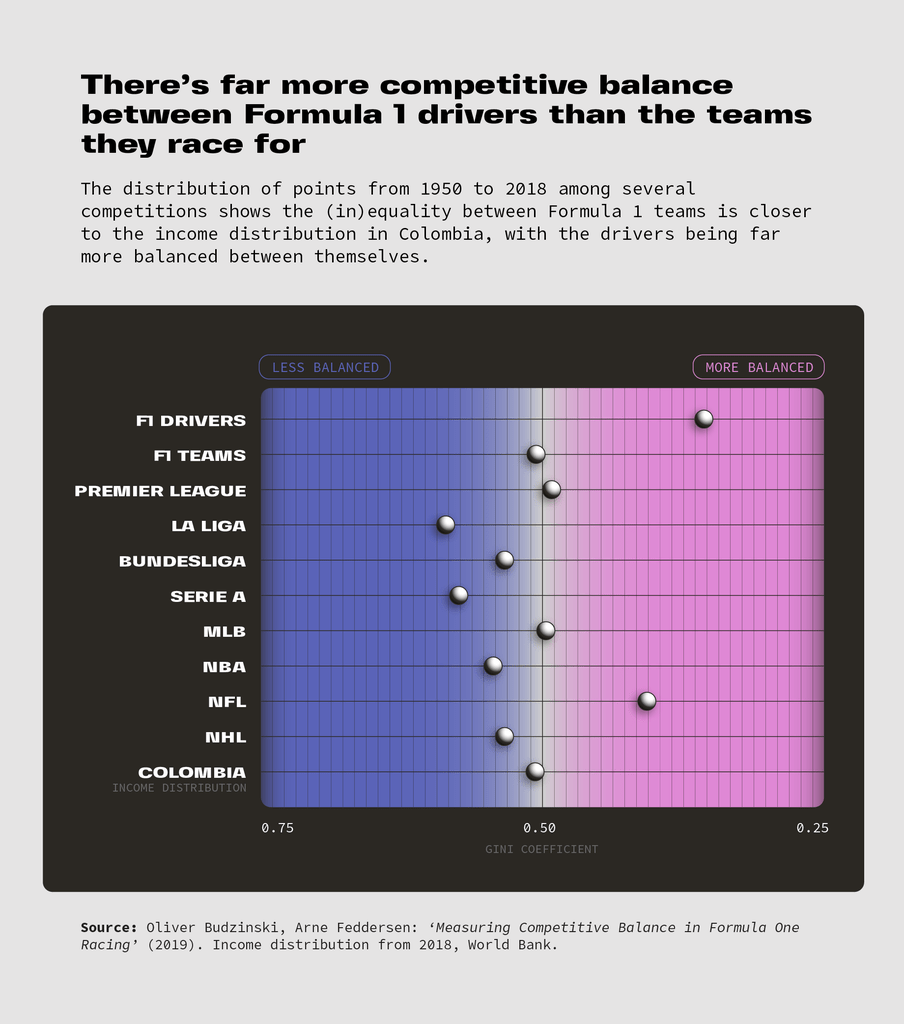
And income matters in motorsport. The relative wealth of Formula One teams can be decisive. From 2021, FIA, the sport’s umbrella organisation, will impose a budget cap on spending of $145 million for Formula One teams. The move is intended to bring a more evenly balanced competition, after both Mercedes and Ferrari spent more than $400 million in 2019. But the new limits exclude drivers’ fees, marketing budgets and salaries of the three highest-paid personnel – raising doubts about the effectiveness of the cap.
Importance of the team
The cameras follow the drivers. That seems to make sense: a driver determines how his car connects to the track, a driver’s hands clasp the steering wheel, his feet move the pedals, eyes flashing between the road and the dashboard. When the FIA changes the rules, their impact is evident most directly on the driver – a championship title may even be delayed, victory claimed one or two races later than before.
But to only watch the drivers is to see Formula One with tunnel vision. It’s data analysts in the paddock who have the more complete view. A Formula One car is fitted with about 150 sensors, generating more than a thousand different data streams. Red Bull, for example, employs no fewer than 90 in-house analysts.
Before the data revolution in sports, “you used to have almost no data, no telemetry, so it was just the driver [on his own]”, former Formula One driver van der Garde told me. “Then, [the distribution] was perhaps 50 percent car, 50 percent driver. Nowadays, there is so much more knowhow within the sport, that the car has become much more important than the driver.”
Or as Pat Symonds, former technical director of the Williams racing team, declared a few years ago: “We’ve achieved the ability to measure pretty well anything we want to measure on the car.” Armed with this data, teams of up to 500 designers, engineers and mechanics prepare for the next race. This kind of intelligence is light years away from the era of solo drivers shouting into the radio that there’s “something wrong” with a car.
The day before a Formula One race, starting positions on the race circuit are allocated by a qualifying round, when drivers compete to set the fastest possible lap time. The Saturday qualifier before Sunday’s main event seems an ideal scenario to make the most of a driver’s individual talent.
For a qualifying round, drivers learn every corner and braking point of a track by heart. But driving conditions are nothing like the actual race. Everything is completely predictable: no evasive manoeuvres, no overtaking, no nail-biting tyre changes. If this were the Tour de France, the closest comparison would be not to an alpine stage, but to a repetitive time trial on the flat. In qualifiers, a driver doesn’t race so much against other drivers as against their lap times, in order to advance on the starting grid for the actual race.
If evidence suggests (and it does) that the key determinants of a Formula One race are the internal efficiency and expertise of the teams – executing pit stops, radio links, intel on everything from weather to surrounding traffic – then the strength and capacity of a team is arguably more decisive for qualifying stage. Here, teams can make more of the all-important decisions. The faster the lap, the less time the driver spends on the track – minimising tyre wear, temperature fluctuations and myriad other stress factors including the risk of accidents.
And what happens on Saturday has a big impact on drivers’ prospects in the race on Sunday. In 2019, a study by German and Danish researchers found that over the past 40 years, the variation between drivers’ starting and finishing positions in Formula One races has been falling.
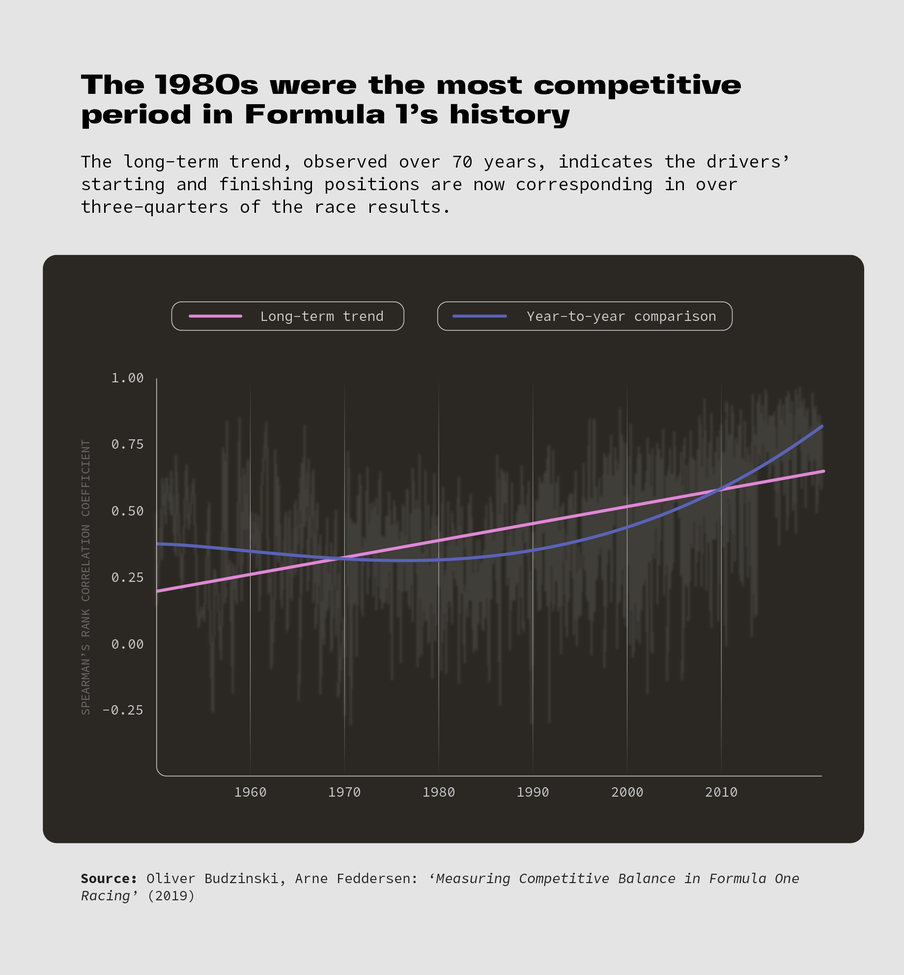
Revenue models: is it about what you spend or how you spend it?
Next to data crunching and engineering brio, a team’s operational management is also crucial to success.
Research from City University in London has shown that it helps if a Formula One brand also builds passenger cars, such as for example Ferrari, Mercedes or Renault. This allows for technology transfer between both production processes, leveraging the knowledge and investment across one company.
Formula One teams with a car manufacturer behind them were found to be better resourced, typically with double the budget of non-carmaker competitors. After six years of observation, the London researchers calculated that carmaker brands picked up more than twice as many Formula One points.
Exceptions are easy to find despite this trend. Red Bull, the Austrian team of Max Verstappen, is relatively successful. Its parent company sells 6.8 billion cans of energy drinks a year, but not a single car. A second factor that can contribute to a successful Formula One team, the British study argued, is a solid youth training academy. Yet another is the competence to harvest data and feedback by selling car parts to other teams.
Two teams excel in training talented youth: Ferrari and, that’s right, Red Bull’s youth academy, which nurtured the careers (among others) of Sebastian Vettel, Daniel Ricciardo and Max Verstappen. In 2015, a potential Ferrari driver emerged via the less well-known teams Marussia and Sauber: the Frenchman Jules Bianchi, widely considered a good prospect for the famous red Italian car, before his tragic death from an accident.
Another strong correlation emerges between top performers and teams with a parallel trade in selling technology and parts. Researchers at City University found that “if a firm sells its engines to [two] other F1 firms, the F1 firm will [have] access [to] technical data from six cars on the racetrack (each F1 firm deploys simultaneously two cars).” Data has become as important to Formula One racing as helmets and gasoline: it’s the feedback which helps to make a car faster, more stable or more reliable, and in the longer term to assess which technologies are further developed for future races and seasons.
The American sports management professor Rodney Fort once lucidly declared: “Teams that spend the most tend to win the most.” But this is not always true. Winning isn’t just about how much money teams spend, it’s about how the deals are done. The specific capacities which result may be as important to the evolution of Formula One as the size of the cheque.
Behind the scenes and under the bonnet
Innovative steps often take place within the walls of the workshop, shielded from the scrutiny of competitors. That’s where the technical edge is sharpened, the car made just a bit faster or smoother before the drivers appear in the garage doorway. But technical leads can evaporate quickly in the open air.
Once the racing world has seen innovations added to cars, the advantage begins to narrow. In the view of legendary team boss Ross Brawn, you’re lucky if you can keep such gains to yourself for even three or four months. That brief window before a season opens, when teams keep hold of such secret recipes, can make an important difference to the championship.
A study by two British academics who tracked three major innovations in the sport – at Ford in the 1960s, Ferrari in the 70s and Williams in the 80s – found their drivers achieved up to five additional points per race, thanks to clever modifications to the engines or chassis.
With an advantage under the bonnet, a team can temporarily outperform the rest. In his book Performance at the Limit, Mark Jenkins, a professor of business strategy, quotes a general manager at Williams on the variety of innovation. It wasn’t one thing, the manager explained, but “a combination of 10 things. Every one of them [saved] two or three hundredths of a second”. Add them up, and a team may get a head start worth a few seconds.
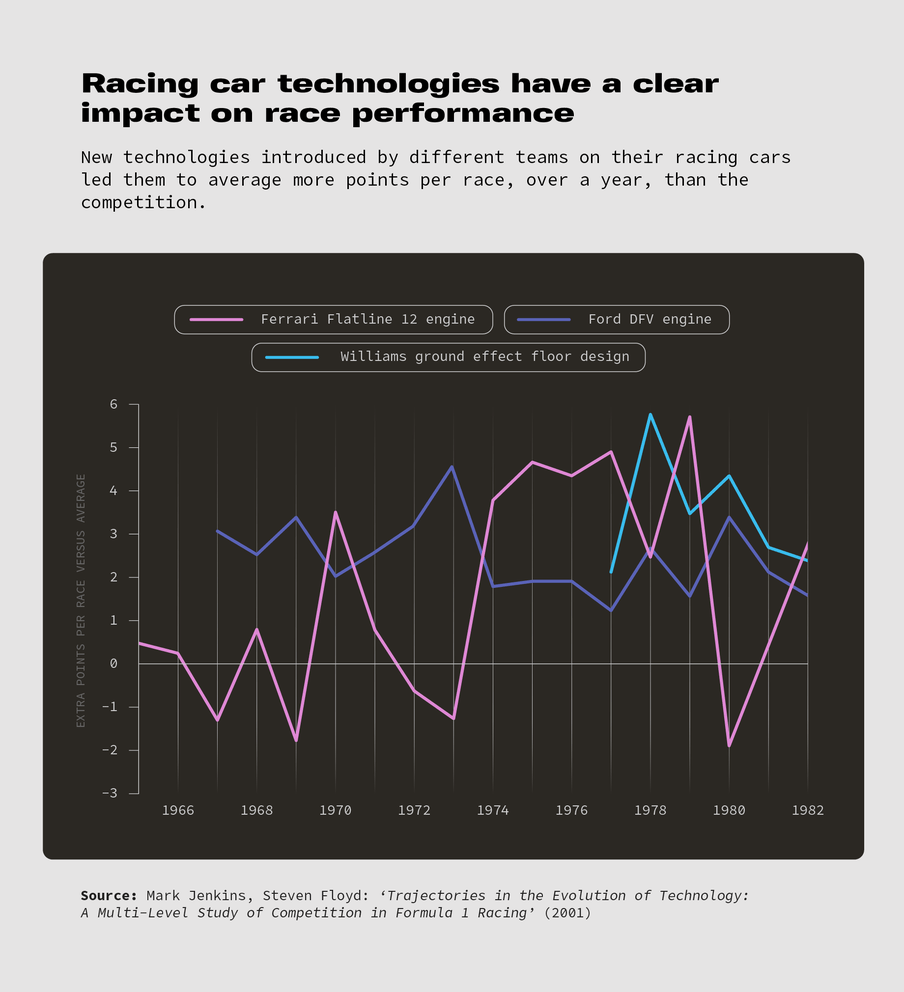
Still, rival teams may be wise to remain cautious at the beginning of a season. By waiting to see from opponents what works and what doesn’t, investors can manage risk and avert financial disaster.
In 2009, for example, Formula One teams pumped $64 million into the development of a Kinetic Energy Recovery System (KERS). The benefits proved marginal: cars fitted with KERS gained only three-tenths of a second in extra speed and saved a meagre 0.021 litres of fuel. In the same season, teams that ignored the hype and didn’t drastically rebuild their engines also performed well. Red Bull finished the championship in second place, a foundation for four consecutive trophies in following years. A brand-new team, Brawn GP, competing for the first and only time, became 2009 world champion.
The points system
The most memorable Formula One seasons owe much to the pairing of legendary drivers. More specifically, to the contests between them: Niki Lauda versus James Hunt, Ayrton Senna against Alain Prost, Lewis Hamilton head-to-head with Nico Rosberg. Those sensational seasons cloud the procedural details which are crucial in every clash of titans.
Let’s take a look at the points system.
Lewis Hamilton, the protagonist of the dramatic 2019 pit stop in Germany, was only 23 years old when he became a Formula One champion. Five more world titles followed. In 2020, he could reach a par with seven-time record-holder Michael Schumacher.
What many people don’t know is that Hamilton’s first championship in 2008 was helped by the points system. His closest competitor, Brazil’s Felipe Massa, stayed ahead of Hamilton in 10 of the season’s 18 races. Thanks to a favourable distribution of points, the Brit took first place with a one-point lead. “Under every point allocation system used prior to 2003 Massa would have won the championship”, noted the American scholar Brian Kaiser.
This begs a tough question: is Hamilton a better driver than Massa because he scored more points? Or was Massa the better driver because he collected more first places that year, although the title was denied him by the system?
Kaiser cites another telling example: 1976. In that season, rebellious Brit James Hunt won by a margin of one point over Austrian Niki Lauda. Famously, Lauda suffered severe burns from a horrific crash. He missed three crucial races. But that’s not the whole story. Kaiser’s analysis points to another factor: the South African driver Jody Scheckter, who finished third in the 1976 championship, “stole” crucial points. If Scheckter’s results hadn’t prevented Lauda from collecting those points, Lauda would have beaten Hunt to win the championship by two points.
The distribution of points at any given time will make or break careers. At least 10 seasons would have produced a different Formula One champion if the points system had been set up slightly differently. For example, had the current system applied to Alain Prost, he would have been a seven-time world champion. “It seems inevitable that the rule-maker plays a role in shaping the outcome,” writes Kaiser, pungently.
Rain falling (like a new emotion)
Critics often complain that Formula One is a predictable sport. Do you really have to sit in front of the TV for two hours to know who’s going to win? In all honesty, no: not usually. You can predict the outcome, mostly. That’s not just an opinion – it’s actually been tested.
Two university employees from South Africa simulated 50 races on three different circuits: the winding Hungaroring in Budapest, the Autodromo with many long straights in the Italian city of Monza, and the Melbourne track with a mix of slow and fast sectors. Their results were amazing: the simulations predicted with great accuracy how the drivers actually performed. For example, on each of the following criteria:
- Finishing positions: three times 97% accurate
- Lap times: 88, 71 and 82% accurate
- Overtaking manoeuvres: 97, 99 and 99% accurate
A fine achievement by the South African scholars, but this result is also somewhat gloomy. What’s so fun about sports that can be predicted so well? Half a billion Formula One viewers worldwide probably each have their own answer to that. At least one of them will be hoping for a gloomy weather forecast.
Huh?
Rain. This is one scenario in which a racing team’s carefully drawn-up roadmaps fall apart. A heavy downpour can turn the conventions of a Formula One race totally upside down. The best example is the Belgian Grand Prix of 1998: a soaking wet, foggy track on which no fewer than twelve cars collided just after the start. Only eight of 22 drivers completed the race.
It doesn’t rain often during a Grand Prix. On the vast majority of race days the sun shines, found researchers Reiner Eichenberger and David Stadelmann from analysis of 768 races. Rain fell on the asphalt in only 15% of races.
But on a rainy day, hell may break loose. Riders skid across the track, choose the wrong tyres, brake too late. Precipitation increases the risk of accidents and overall has “a negative and significant influence,” Eichenberger and Stadelmann conclude. From the viewer’s perspective, as several analysts have noted, rain causes “less predictable results” and “increasing spectator excitement”.
In the rain, drivers must adapt. They become more careful, drive slower, take fewer risks in the corners and overtake less. The power advantage on a dry, straight road surface of – say – a Ferrari engine is suddenly reduced over – say – the less powerful Williams car. The finesse of a Red Bull car in the curves no longer delivers the same lead over rivals.
“As a driver, you can get more out of [rain] than you can on dry land,” former Formula One driver van der Garde tells me. “On dry roads, everyone knows where the braking points are and how fast you can go through a corner. With rain, the question is always: how far can you go? Where is the grip? It all comes down to feeling. That’s what you’ve seen in my era: [suddenly] you’re in fourth place with a Caterham that’s normally three and a half seconds slower [than the top cars].”
Analysis of 64 Formula One seasons by Phillips shows that 53% of races in dry weather were won by a car from the same year’s winning team. On a wet track in the rain, that figure fell to 44%. That difference may seem small, but over the course of 64 years, the impact of wet weather has been felt in almost 100 Formula One races.
Drivers including Ayrton Senna, Gilles Villeneuve and Jenson Button proved their full potential in the rain. Michael Schumacher is an exception: his performance proved just as stable on wet roads as he was on dry asphalt. Overall, however, rainfall is like pressing reset in a race. The odds shrink, advantages on the dry circuit are evened out in the rain, differences between teams are reduced.
In the rain, anyone can win or lose – gloriously, with or against the odds. More than in other conditions, the driver is back in control: he becomes the puppeteer and master of his car, instead of the other way around.
Predictable? Another take
Let’s go back one more time to Lewis Hamilton’s 2019 pit stop. How did the Brit get to a point where his car’s front wing needed to be replaced? You guessed it: rain. Hamilton was struggling, and Mercedes’s strategy drowned in the water.
So, remember this. If you turn on the television on a Sunday and zap to the Grand Prix, the guy in the car in front is not necessarily the best driver. Likewise, the schmuck trailing at the back probably has more talent than you think – he’s just sitting in the wrong car. We can all hope that talent spotters in charge of the best-performing teams are willing to look beyond that. Or, at the very least, that next time it’ll rain.
“Much of the sport is already decided before the drivers get on the track,” researcher Andrew Bell notes. “Does that make people less interested? Possibly, but in a sense that’s the case with lots of sports. People still like to watch the best football team in the world, even if they have been the best team for a long time and consistently beat their opponents.”
The 80/20 rule – Nico Rosberg’s rule of thumb, that Formula One results can be attributed 80% to a team, and 20% to the driver – is too reductive. Other factors are crucial: the performance in any given race is heavily influenced by the weather, by the starting positions determined by Saturday’s qualifying round, and by the points system. Taking all these into account, maybe the balance of success factors rapped out in Fort Minor’s hit song is closer to the truth after all.
Dig deeper
 The curious tale of the football international nobody ever heard of (because he was born in the wrong month)
At the highest level in sports, the month of your birth can determine your chances of success to a startling degree. Steve Lawrence, father of a gifted football player born in the wrong month, discovered this ‘relative age effect’ – and fought to save his son’s career.
The curious tale of the football international nobody ever heard of (because he was born in the wrong month)
At the highest level in sports, the month of your birth can determine your chances of success to a startling degree. Steve Lawrence, father of a gifted football player born in the wrong month, discovered this ‘relative age effect’ – and fought to save his son’s career.
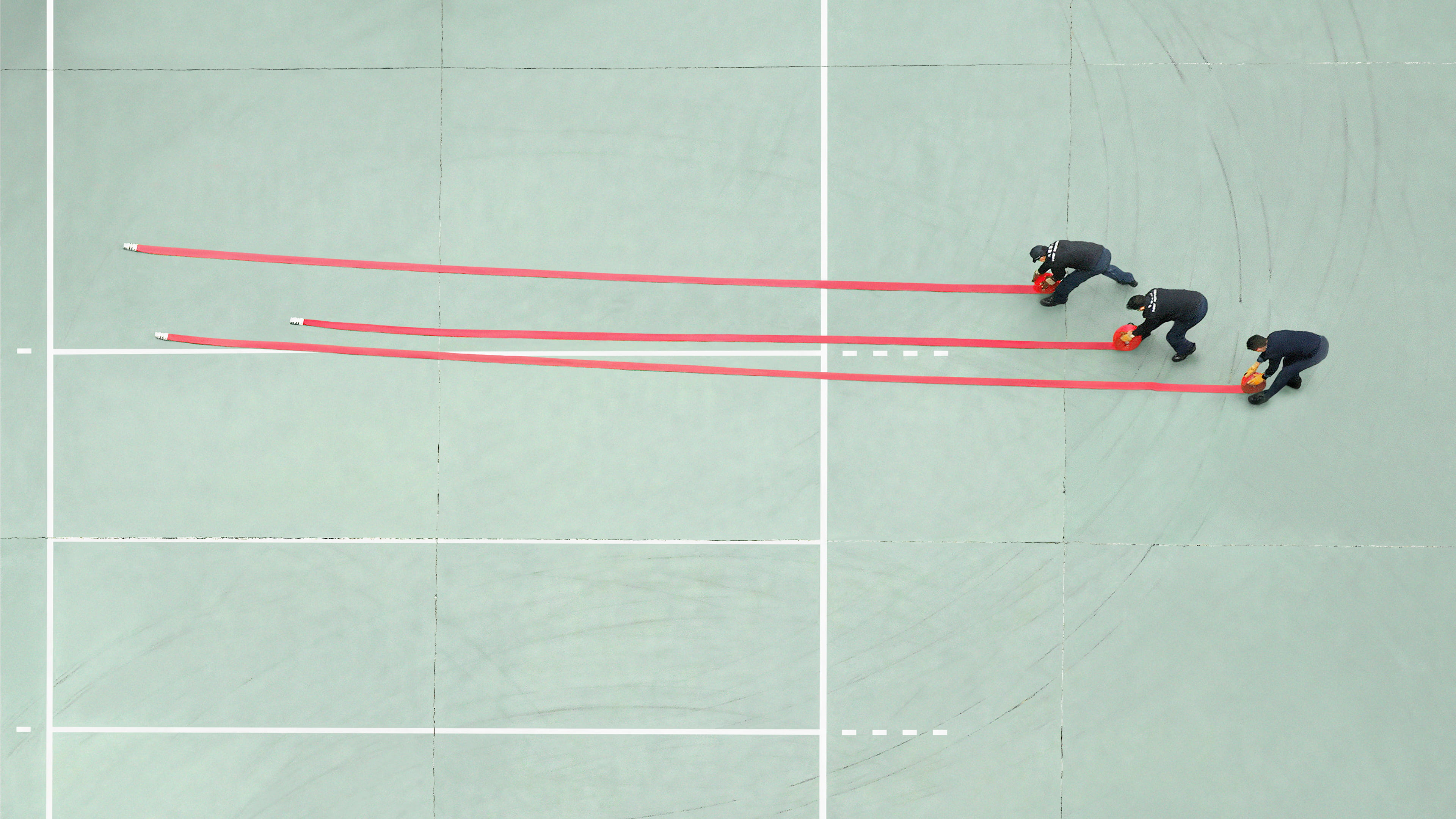 Once more, for feeling: why trying new things is overrated (and repetition is vital to society)
We’re constantly told to try something new. ‘Innovate, don’t stagnate.’ But doing things two, three or 30 times creates space for reflection – and innovation. And it can even bring unexpected joy.
Once more, for feeling: why trying new things is overrated (and repetition is vital to society)
We’re constantly told to try something new. ‘Innovate, don’t stagnate.’ But doing things two, three or 30 times creates space for reflection – and innovation. And it can even bring unexpected joy.


